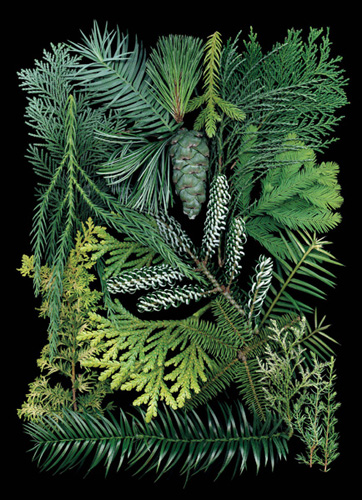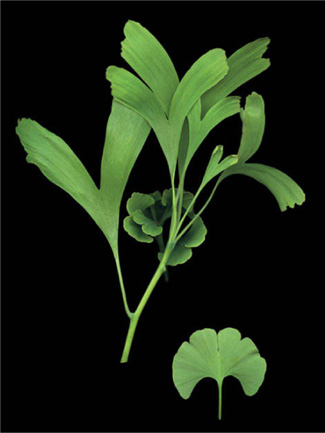
Conifers: A Chamaecyparis lawsoniana; B Cunning-hamia lanceolata ‘Glauca’; C Pinus mugo; D Cryptomeria japonica ‘Gyokuryu’; E Sequoiadendron giganteum ‘Hazel Smith’; F Chamaecyparis pisifera; G Taxodium distichum ‘Peve Minaret’; H Torreya nucifera ‘Snowcap’; I Chamaecyparis thyoides ‘Miko’; J Juniperus communis ‘Gold Cone’; K Cunning-hamia lanceolata; L Chamaecyparis obtusa ‘Fernspray Gold’; M Cryptomeria japonica ‘Ben Franklin’; N Pinus parviflora ‘Glauca’; O Abies koreana ‘Horstmann’s Silberlocke’; P Abies pinsapo; Q Thujopsis dolbrata ‘Aurea’.

Conifers—cone-bearing woody plants like pine, cedar, hemlock, and spruce—adapted to their world by inventing revolutionary ways to do just about everything. These trees bear narrow, thick-skinned needles with waxy coatings to reduce evaporation in windy locations and in cold weather when water may be locked in the frigid soil. The conifers do not rely on insects for pollination; instead, they produce enormous quantities of pollen to be carried far and wide by the wind.
However, these “new” improvements originated about 380 million years ago, between the primitive moisture-loving mosses and ferns and what is arguably the most pleasing of nature’s developments: showy flowers. Conifers are called gymnosperms (naked seed) since they do not produce fleshy or dry fruits. Their seeds form on the tips of short stalks or between the scales of their cones.
We think of conifers as having needles; however, ancient cycads have palm-like fronds, and ginkgo trees have broad leaves. Rather than being evergreen, the ginkgo drops its leaves in the autumn, as do some needle-leafed deciduous trees such as swamp cypress (Taxodium), larch (Larix), and the dawn redwood (Metasequoia).
Evergreen trees may be used as singular specimens, or planted in groups for screens and windbreaks. Evergreen shrubs, often pruned trees, serve similar purposes. We are all familiar with hedges of clipped yew (Taxus spp. and varieties). These living fences also make excellent backgrounds for flower plantings. Naturally low-growing, spreading Juniperus horizontalis and J. procumbens may be planted as ground covers.
Some conifers are among the tallest and oldest living things on earth. The same trees may be the sources of diminutive cultivars typified by compact, slow growth— some adding less than an inch per year. These dwarfs may have originated as mutations that appeared on normal tree branches. Particularly prized individuals have to be propagated vegetatively from cuttings to make identical clones. Collectable dwarfs and miniature dwarfs may have innate shapes such as globes, pyramids, or obelisks, and exhibit colored needles with gold or purple casts or white variegations.
Not all conifers have needles; Ginkgo biloba for example, including cultivars like fishtail ‘Saratoga’ in front of tubular ‘Todd’s Broom’.
